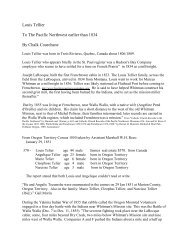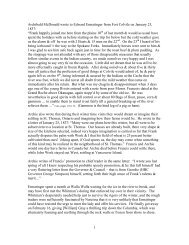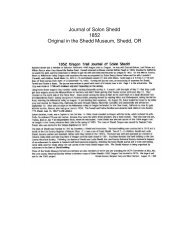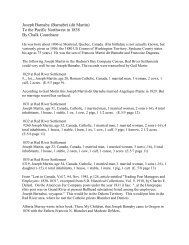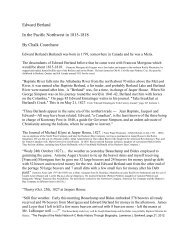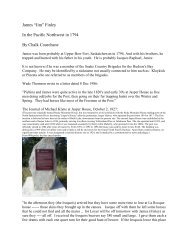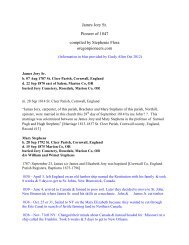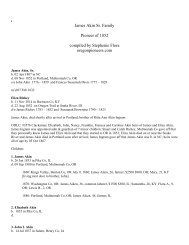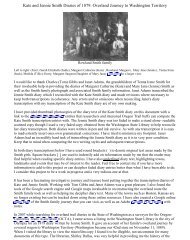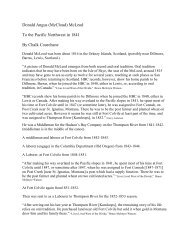(297) Ref: The Newcomer Population Grows – <strong>Oregon</strong> History Project: “In July 1846, Lieutenant Neil M. Howisonarrived at Astoria with orders to “obtain correct information of that country <strong>and</strong> to cheer our citizens in <strong>the</strong> region by<strong>the</strong> presence of <strong>the</strong> American flag.” President James K. Polk had sent Howison to find out what was going on in <strong>the</strong><strong>Oregon</strong> Country. Polk needed some support for his hard-time position on <strong>the</strong> Untied States’ long-running boundarydispute with Britain, summarized in Polk’s truculent slogan, (Fifty-four Forty or Fight).”Ref: <strong>Oregon</strong> Blue Book; <strong>Oregon</strong> History Bibliography: “During <strong>the</strong> period 1792 to 1846, <strong>the</strong> U.S. government thusaided <strong>and</strong> abetted American interest in <strong>Oregon</strong>. The nation's leaders, both public <strong>and</strong> private, took actions to helpbuttress claims to <strong>Oregon</strong> through discovery, diplomacy, exercise of will, <strong>and</strong> <strong>the</strong> persuasive historical research ofRobert Greenhow. The explorations of Lewis <strong>and</strong> Clark, Slacum, <strong>the</strong> Wilkes expedition, John Fremont, <strong>and</strong> Neil M.Howison generated maps, reports, <strong>and</strong> collections of specimens. These were analyzed <strong>and</strong> published. The evidencewas growing about <strong>the</strong> prospects of <strong>the</strong> Pacific Northwest, <strong>and</strong> <strong>Oregon</strong> in particular.”(298) Ref: Botany – Wikipedia, <strong>the</strong> free encyclopedia: “Claytonia (Spring Beauty) is a genus of 26species of flowering plants in <strong>the</strong> family Portulaceae, primarily native to North America; Claytonia perffoliata, <strong>the</strong>species for which <strong>the</strong> term miner's lettuce was coined, is distributed throughout <strong>the</strong> Mountain West of NorthAmerica in moist soils <strong>and</strong> prefers areas which have <strong>been</strong> recently disturbed.”(299) Ref: Botany – Wikipedia, <strong>the</strong> free encyclopedia: “Viola is a genus of flowering plants in <strong>the</strong> violetfamily Violaceae (Violets), with around 400–500 species distributed around <strong>the</strong> world. Most species are found in <strong>the</strong>temperate Nor<strong>the</strong>rn Hemisphere.”(300) Ref: Botany – Wikipedia, <strong>the</strong> free encyclopedia: “Stellaria is a genus of about 90-120 speciesflowering plants in <strong>the</strong> family Caryophyllaceae, with a cosmopolitan distribution. Common names include stitchwort<strong>and</strong> chickweed.”(301) Ref: Botany – Wikipedia, <strong>the</strong> free encyclopedia: “Dodeca<strong>the</strong>on is a genus of herbaceousflowering plants in <strong>the</strong> Primrose family Primulacea. The species have basal clumps of leaves <strong>and</strong> nodding flowersthat are produced at <strong>the</strong> top of tall stems that rise from where <strong>the</strong> leaves join <strong>the</strong> crown. They are commonly calledShooting Stars because of <strong>the</strong> flower shape. The genus is largely confined to North America, <strong>and</strong> part ofnor<strong>the</strong>astern Siberia. Common names also include, American Cowslip, Mosquito Bills, Mad Violets, <strong>and</strong> Sailorcaps.”(302) Ref: Botany – Wikipedia, <strong>the</strong> free encyclopedia: “Clover (Trifolium), or trefoil, is a genus ofabout 300 species of plants in <strong>the</strong> pea family Fabaceae. The genus <strong>has</strong> a cosmopolitan distribution, <strong>the</strong> highestdiversity is found in <strong>the</strong> temperate Nor<strong>the</strong>rn Hemisphere. O<strong>the</strong>r closely related genera often called clovers includeMelilotus (sweet clover) <strong>and</strong> Medicago (alfalfa) or 'calvary clover'). The “shamrock” of popular iconography issometimes considered to be young clover. The scientific name derives from <strong>the</strong> Latin tres, "three", <strong>and</strong> folium,"leaf", so called from <strong>the</strong> characteristic form of <strong>the</strong> leaf, which <strong>has</strong> three leaflets (trifoliate); hence <strong>the</strong> popular nametrefoil.”(303) Ref: Botany – Wikipedia, <strong>the</strong> free encyclopedia: “Collinsia is a genus of about 25 species ofannual flowering plants, consisting of <strong>the</strong> Blue-eyed Marys <strong>and</strong> <strong>the</strong> Chinese Houses. It was traditionally placed in<strong>the</strong> snapdragon family
Scrophulariaceae, but following recent research in, it <strong>has</strong> now <strong>been</strong> placed in a much enlarged familyPlantaginaceae. The genus is endemic to North America, <strong>and</strong> is named in honour of Zacchaeus Collins, aPhiladelphia botanist of <strong>the</strong> late eighteenth/early nineteenth century. There are about 20 species, many of <strong>the</strong>mfound in California.”(304) Ref: Botany – Wikipedia, <strong>the</strong> free encyclopedia: “Leptosiphon is a genus of flowering plants in<strong>the</strong> Polemoniacea family. Many included species were formerly classified as members of <strong>the</strong> genus Linanthus. Somespecies of this genus are grown as ornamental plants.”(305) Ref: botany – Britannica OnLine Encyclopedia: “Scilla pertains to any of <strong>the</strong> bulbous plants of <strong>the</strong>genus Scilla of <strong>the</strong> family Hyacinthaceae, consisting of about 100 species, native to temperate Eurasia. The narrow,sometimes grass--like leaves, arise from <strong>the</strong> base of <strong>the</strong> plant. The squill’s small white, blue, or purple flowers areborne in a cluster at <strong>the</strong> tip of a leafless flower stalk. Some spring-flowering species are cultivated as gardenornamentals.”(306) Ref: HistoryLink Essay: Wilkes ezpedition sailing vessel….: “The Porpoise is part of <strong>the</strong> UnitedStates Exploring Expedition comm<strong>and</strong>ed by Lt. Charles Wilkes (1798 – 1877). She is, in <strong>the</strong> words of MurrayMorgan, ‘224 tons, 88 feet long, two-masted, rigged as a brigantine, carrying sixty-five men <strong>and</strong> under <strong>the</strong> comm<strong>and</strong>of Cadwallader Ringgold.”(307) Ref: USS Vincennes (1826) – Wikipedia, <strong>the</strong> free encyclopedia: “Vincennes – <strong>the</strong> first Americanship to be so named – was one of ten sloops of war whose construction was authorized by Congress on 3 March1825. She was laid down at New York in 1825, launched on 27 April 1826, <strong>and</strong> commissioned on 27 August1826,….she was re-fitted with a light spar deck <strong>and</strong> declared <strong>the</strong> flagship of <strong>the</strong> South Sea Surveying <strong>and</strong> ExploringExpedition to <strong>the</strong> Antarctic region.”(308) Ref: Merriam Webster’s Collegiate Dictionary: is one, who is skilled in public praise orlaudation.(309) Ref: Botany – Wikipedia, <strong>the</strong> free encyclopedia: “Gaul<strong>the</strong>ria is a genus of about 170-180 speciesof shrubs in <strong>the</strong> family Ericacea. The name memorializes M. Hugues Gauthier of Quebec, a mis-spelt honourbestowed by <strong>the</strong> Sc<strong>and</strong>inavian Pehr Kalm in 1748. These plants are native to Asia, North <strong>and</strong> South America, <strong>and</strong>Australasia.”(310) Ref: Botany – Wikipedia, <strong>the</strong> free encyclopedia: “Vaccinium is a genus of shrubs or dwarfshrubs in <strong>the</strong> plant Family Ericaceae. The fruit of many species are eaten by humans <strong>and</strong> some are of commercialimportance, including <strong>the</strong> cranberry, blueberry, bilberry or whortleberry, lingonberry or cowberry, <strong>and</strong> huckleberry.”(311) Ref: Seringia aborescens: Seringia pertains to a plant genus consisting of a wide variety of subspecies.Thornton, may possibly, have encountered: “Seringia arborescens: A tall shrub to 8 m. high with youngbranches rusty-tomentose. Leaves ovate to lanceolate, mostly 5-15 cm long, 1.5-6 cm wide, glabrous or almost so onupper surface, stellate-tomentose <strong>and</strong> with main veins raised <strong>and</strong> rusty-tomentose on lower surface, petiole 5-10 mmlong.”CHAPTER XVIII
- Page 1 and 2: Don Ubben has been researching the
- Page 3: Buchanan, of Lexington, Ky., joined
- Page 7 and 8: (32) Edwin Bryant, also makes menti
- Page 9 and 10: On Dec. 23, 1819 Harriet married (2
- Page 11 and 12: William S. Clark left Independence
- Page 13 and 14: Lee Co., VA). James & Hannah moved
- Page 15 and 16: Dorintha Shaunce, was born Feb. 13,
- Page 17 and 18: Chimney Rock is 4,226 feet (1,288 m
- Page 19 and 20: 1870 at Rosebud Indian Reservation,
- Page 21 and 22: with the formula NaHCO3. Sodium bic
- Page 23 and 24: was a matter of pure chance that th
- Page 25 and 26: (141) Ref: Ribes irriguum-Plants Fo
- Page 27 and 28: (153) Ref: Emigrants to Oregon in 1
- Page 29 and 30: southern route into Oregon Territor
- Page 31 and 32: wagons.” William D. had already d
- Page 33 and 34: CHAPTER X(183) William Stokes was b
- Page 35 and 36: York Supreme Court, in 1804 Chief J
- Page 37 and 38: (204) Ref: Brittanica Encyclopedia:
- Page 39 and 40: (214) Ref: The Applegate Trail Inte
- Page 41 and 42: Benjamin born in 1818; died in 1852
- Page 43 and 44: (247) Ref: Latin - Definition and M
- Page 45 and 46: greatest explorers. The maps he dre
- Page 47 and 48: an intelligent gentleman, and is al
- Page 49: and pioneer in the Oregon Country i
- Page 53 and 54: (323) Ref: Fourth edition of Rev. S
- Page 55 and 56: celandine of the poppy family Papav
- Page 57 and 58: species, etc.”(362) Ref: Wikipedi



